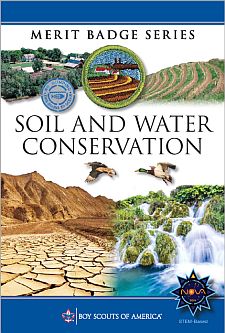NOTE:
A number of changes to the text of the requirements for this merit badge
were first published in the Soil and Water Conservation merit badge pamphlet
(#33291A) issued in 2004. The revised requirements were also included in
the version of the pamphlet issued in 2008 (#35952) and in the 2010 revision
of the 2004 edition (#35952 - SKU 610016) and each printing of each of those
editions. However, the revised text was not included the 2005 edition of
Boy Scout Requirements, nor in any of the subsequent editions of
that booklet, up to and including the 2020 edition, nor on Scouting.org which have all included
the older wording of the requirements.
What is shown below are the differences between the official text as it appeared in Boy Scout Requirements and now appears on scouting.org, and the text which has been used in the merit badge pamphlets.
- Do the following:
- Tell what soil is. Tell how it is formed.
- Describe three kinds of soil. Tell how they are different.
- Name the three main plant nutrients in fertile soil. Tell how they can be put back when used up.
- Do the following:
- Define soil erosion.
- Tell why it soil conservation is important. Tell how it affects you.
- Name three kinds of soil erosion. Describe each.
- Take pictures of or draw two kinds of soil erosion.
- Do the following:
- Tell what is meant by "conservation practices".
- Describe the effect of three kinds of erosion-control practices.
- Take pictures of or draw three kinds of erosion-control practices.
- Do the following:
- Explain what a watershed is.
- Outline the smallest watershed that you can find on a contour map.
- Then outline on your map, Outline, as far as possible the map will allow, the next larger watershed which that also has the smallest smaller one in it.
- Explain what a river basin is. Tell why all people living in a river basin should be concerned about land and water use in it the basin.
- Do the following:
- Make a drawing to show the hydrologic cycle.
- Show by demonstration Demonstrate at least two of the following actions of water in relation to the soil: percolation, capillary action, precipitation, evaporation, transpiration.
- Explain how removal of vegetation will affect the way water runs off a watershed.
- Tell how uses of forest, range, and farm land farmland affect usable water supply.
- Explain how industrial use affects water supply.
- Do the following:
- Tell what is meant by "water pollution".
- Describe common sources of water pollution and explain the effects of each.
- Tell what is meant by "primary water treatment," "secondary waste treatment," and "biochemical oxygen demand."
- Make a drawing showing the principles of complete waste treatment.
- Do TWO of the following:
- Make a trip to two of the following places. Write a report of
more than 500 words about the soil and water and energy conservation
practices you saw.
- An agricultural experiment.
- A managed forest or a woodlot, range, or pasture.
- A wildlife refuge or a fish or game management area.
- A conservation-managed farm or ranch.
- A managed watershed.
- A waste-treatment plant.
- A public drinking water treatment plant.
- An industry water-use installation.
- A desalinization plant.
- Plant 100 trees, bushes and/or vines for a good purpose.
- Seed an area of at least1/5 one-fifth acre for some worthwhile conservation purpose purposes, using suitable grasses or legumes alone or in a mixture.
- Study a soil survey report. Describe the things in it. On Using tracing paper and pen, trace over any of the soil maps, and outline an area with three or more different kinds of soil. List each kind of soil by full name and map symbol.
- Make a list of places in your neighborhood, camps, school ground, or park having erosion, sedimentation, or pollution problems. Describe how these could be corrected through individual or group action.
- Carry out any other soil and water conservation project approved by your merit badge counselor.
- Make a trip to two of the following places. Write a report of
more than 500 words about the soil and water and energy conservation
practices you saw.
BSA Advancement ID#:
106
Requirements last updated in:
2005
Pamphlet Publication Number:
35952
Pamphlet Stock (SKU) Number:
610016
Pamphlet Revision Date:
2010
|
|||||||
Page updated on: November 18, 2021









